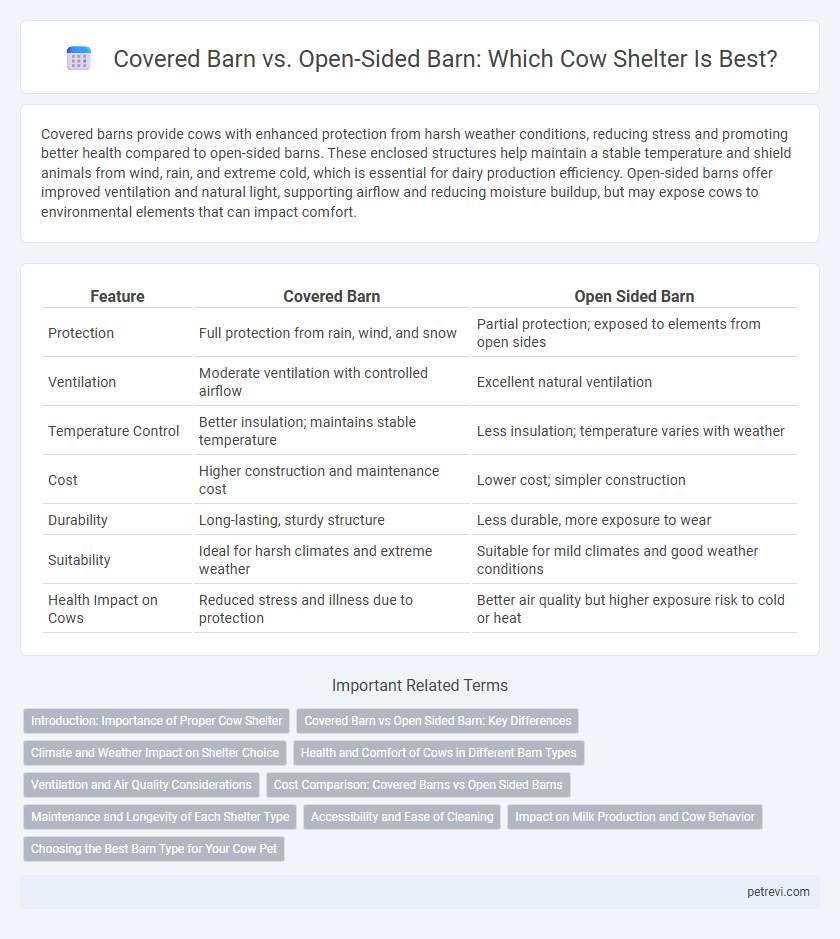Covered barns provide cows with enhanced protection from harsh weather conditions, reducing stress and promoting better health compared to open-sided barns. These enclosed structures help maintain a stable temperature and shield animals from wind, rain, and extreme cold, which is essential for dairy production efficiency. Open-sided barns offer improved ventilation and natural light, supporting airflow and reducing moisture buildup, but may expose cows to environmental elements that can impact comfort.
Table of Comparison
| Feature | Covered Barn | Open Sided Barn |
|---|---|---|
| Protection | Full protection from rain, wind, and snow | Partial protection; exposed to elements from open sides |
| Ventilation | Moderate ventilation with controlled airflow | Excellent natural ventilation |
| Temperature Control | Better insulation; maintains stable temperature | Less insulation; temperature varies with weather |
| Cost | Higher construction and maintenance cost | Lower cost; simpler construction |
| Durability | Long-lasting, sturdy structure | Less durable, more exposure to wear |
| Suitability | Ideal for harsh climates and extreme weather | Suitable for mild climates and good weather conditions |
| Health Impact on Cows | Reduced stress and illness due to protection | Better air quality but higher exposure risk to cold or heat |
Introduction: Importance of Proper Cow Shelter
Proper cow shelter is essential for maintaining animal health, productivity, and welfare. Covered barns offer protection from extreme weather conditions, reducing stress and preventing illnesses in cows. Open sided barns provide ventilation and natural airflow, which helps control humidity and temperature, promoting comfort and preventing respiratory issues.
Covered Barn vs Open Sided Barn: Key Differences
Covered barns provide superior protection from extreme weather conditions such as rain, wind, and snow, ensuring consistent shelter for cows and reducing stress-related health issues. Open sided barns offer better ventilation, promoting airflow that helps control humidity and heat, which is beneficial in warmer climates. The choice between covered and open sided barns depends on regional climate, cow comfort needs, and farm management practices to optimize animal welfare and productivity.
Climate and Weather Impact on Shelter Choice
Covered barns provide better protection against extreme weather conditions such as heavy rain, snow, and strong winds, ensuring cows remain dry and warm, which is crucial for maintaining health and milk production. Open-sided barns offer superior ventilation, reducing heat stress in hot and humid climates while allowing natural airflow to prevent respiratory issues. Choosing between covered and open-sided barns depends largely on the local climate, with covered barns suited for colder, wetter regions and open-sided designs preferred in warmer, drier environments.
Health and Comfort of Cows in Different Barn Types
Covered barns provide cows with consistent protection from extreme weather elements such as rain, wind, and direct sunlight, significantly reducing stress and respiratory illnesses. Open sided barns enhance ventilation and air circulation, which helps maintain cooler temperatures and reduces the risk of heat stress and moisture buildup that can lead to hoof problems. Choosing the appropriate barn type depends on regional climate, but optimizing shelter design directly impacts cow health, comfort, and overall productivity.
Ventilation and Air Quality Considerations
Covered barns for cow shelter provide better protection from adverse weather but may require enhanced ventilation systems to maintain optimal air quality and reduce ammonia buildup. Open-sided barns promote superior airflow, naturally minimizing moisture and airborne pathogens, which supports respiratory health in cows. Proper ventilation in both designs is crucial to prevent heat stress and improve overall animal welfare.
Cost Comparison: Covered Barns vs Open Sided Barns
Covered barns for cow shelter generally incur higher initial construction costs due to comprehensive roofing and wall materials compared to open sided barns, which utilize minimal structural components. Maintenance expenses for covered barns are also typically greater, given the need to repair enclosed structures and potential climate control systems. However, open sided barns offer cost savings in ventilation and natural lighting but may result in higher livestock health management costs due to increased exposure to weather elements.
Maintenance and Longevity of Each Shelter Type
Covered barns provide enhanced protection against weather elements, reducing wear and tear on structural materials and lowering maintenance frequency compared to open sided barns. Open sided barns allow better ventilation but expose the framework to rain, snow, and wind, accelerating deterioration and increasing maintenance needs. Choosing covered barns can improve longevity by shielding surfaces from moisture-related damage, while open sided barns require more frequent inspections and repairs to maintain structural integrity.
Accessibility and Ease of Cleaning
Covered barns provide better protection from harsh weather, enhancing cow comfort and health, while open-sided barns offer superior ventilation and easier access for both animals and caretakers. In terms of cleaning, open-sided barns allow more natural air circulation, reducing moisture buildup and facilitating quicker drying of floors and bedding, thus simplifying maintenance. Covered barns may require more intensive cleaning routines due to enclosed spaces prone to humidity and manure accumulation.
Impact on Milk Production and Cow Behavior
Covered barns provide a controlled environment that reduces stress and exposure to weather extremes, directly enhancing cow comfort and increasing milk production by up to 10%. Open-sided barns offer improved ventilation and natural light, which promotes natural cow behaviors and reduces respiratory issues, but may expose cows to temperature fluctuations affecting lactation consistency. Choosing the optimal barn type requires balancing shelter protection with airflow to maximize milk yield and support healthy cow behavior.
Choosing the Best Barn Type for Your Cow Pet
Covered barns provide essential protection from harsh weather, ensuring cows stay dry and comfortable, which supports their health and productivity. Open-sided barns offer excellent ventilation, reducing heat stress and improving air quality while still offering some shelter from sun and light rain. Choosing the best barn type depends on climate, cow breed, and management practices, with covered barns favored in colder, wetter regions and open-sided barns preferred in warmer, drier areas.
Covered Barn vs Open Sided Barn for Cow Shelter Infographic

 petrevi.com
petrevi.com